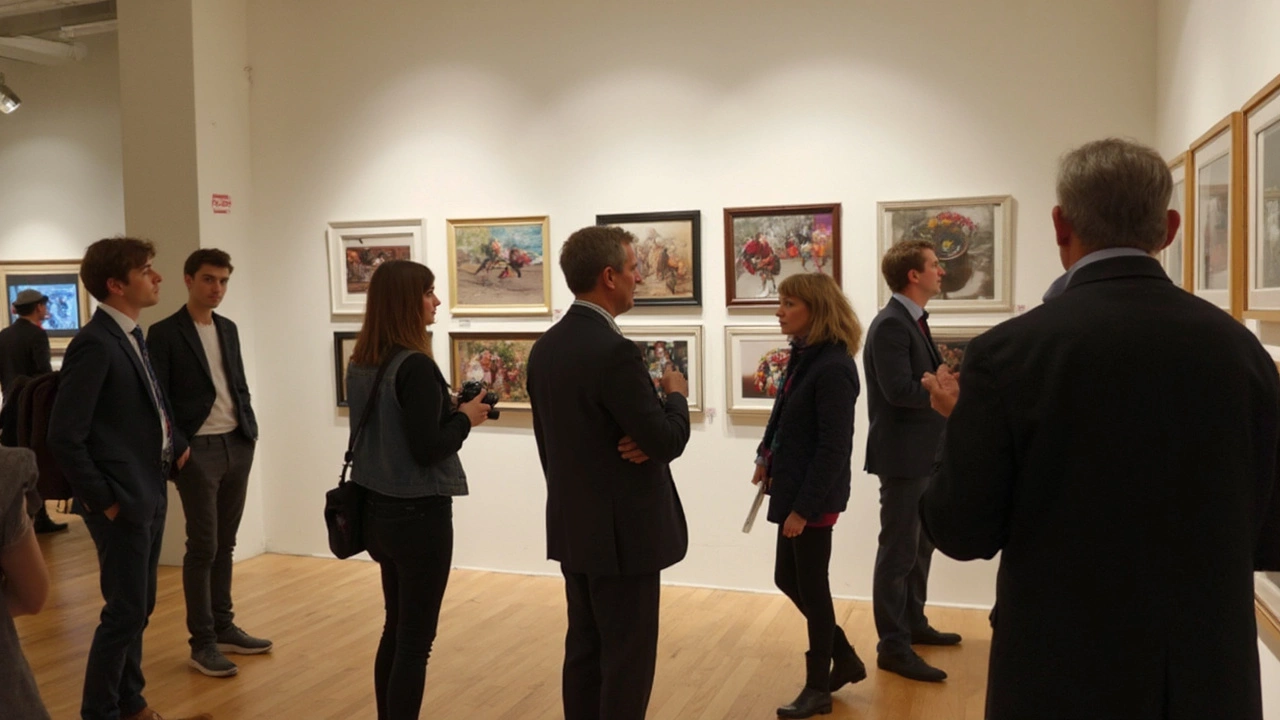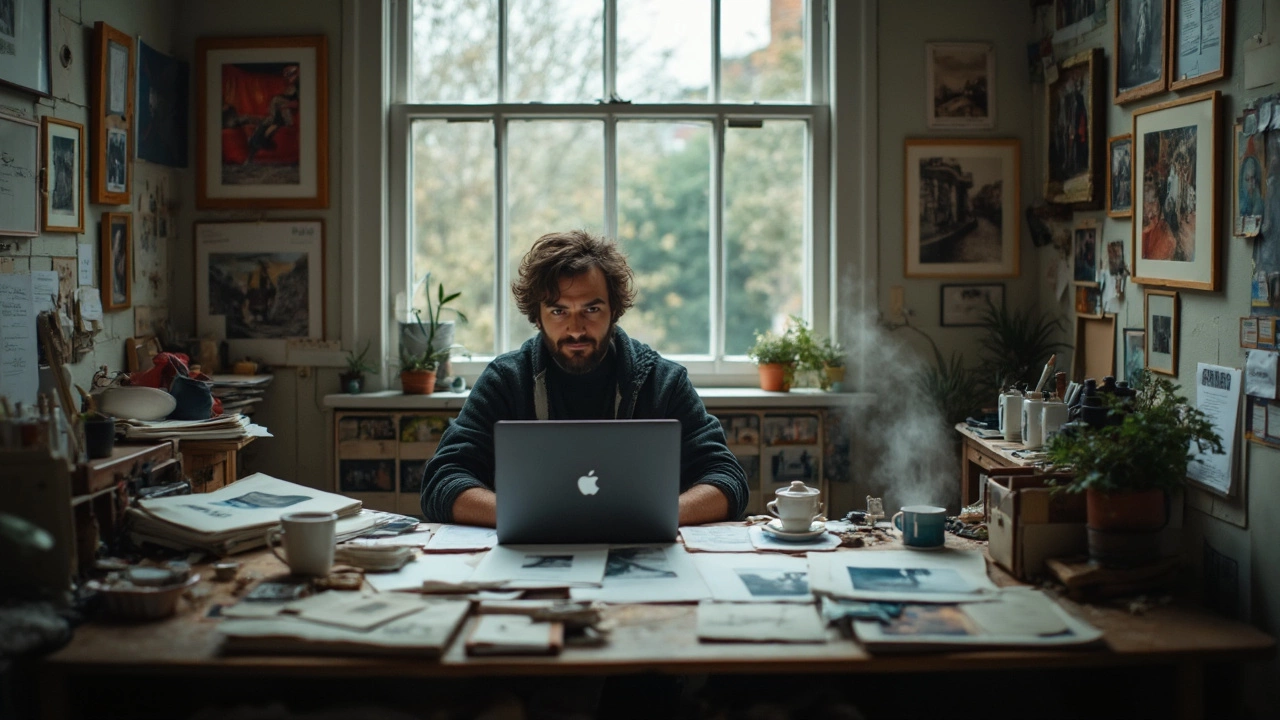Most people think of fine art photographers as creative souls wandering around misty hills with expensive cameras, striking gold every time they snap a moody shot. But making a full-time living from this? It’s not that simple—and the real story is way more complicated (and honestly, a lot more interesting).
So, can you actually pay your rent just by selling your photos as art? The short answer: Some do, most don’t—at least not only by selling prints. Fine art photography is less about those rare million-dollar gallery sales and more about juggling multiple income streams. Think of it as a business (because, honestly, it is), not just a passion project.
If you want to pay your bills with your camera, you’ll need to get strategic—about your brand, your audience, your prices, and where you show your work. There are proven ways to boost your odds, and it’s not just luck. The first step is understanding what you're really selling and who cares enough to buy. Ready to see how the business side of fine art photography works? Let’s get real about what you’re up against—and what you can do to actually make it work.
- Fine Art Photography: What Does It Actually Mean?
- How Fine Art Photographers Really Earn Money
- Where and How to Sell Your Work
- Pricing, Editions, and Building Value
- Marketing Yourself Without Feeling Pushy
- Common Struggles and How to Beat Them
Fine Art Photography: What Does It Actually Mean?
Fine art photography gets thrown around a lot, but what does it really mean? First off, it’s not about snapping pretty landscapes just because they look nice. Instead, it’s about making images that have a personal vision or message behind them. The photographer treats the camera as a tool for expressing ideas, not just recording what’s in front of them.
There’s no checklist for what counts as fine art versus just ‘nice photos.’ But people in the art world usually look for a few things:
- The images are intentional—every choice in style or subject is deliberate.
- The photographer has a recognizable voice or theme. People can often pick out their work just from the style.
- The work is often meant to be shown in galleries, sold as limited-edition prints, or collected. It’s not made for clients or for commercial uses.
You’ll spot fine art photographers doing everything from self-portraits to abstract city scenes or surreal edits. What ties them together is that their work isn’t really about documenting reality. It’s about starting conversations or making people feel something.
One thing that separates fine art photography from most commercial or editorial work is control. The artist usually controls every part of the process—planning, shooting, editing, printing, and even how the work is displayed.
When the International Center of Photography ran a survey last year, about 70% of art collectors said they look for unique vision and consistency when buying photographs. It’s not about gear or technical tricks; it’s about the story.
People sometimes try to blur the lines between personal work and art for sale, but in the end, fine art photography is about personal expression first. If you want to get serious in this field, start thinking less ‘How do I make a pretty picture?’ and more ‘What am I trying to say?’ That’s what separates you from the crowd.
How Fine Art Photographers Really Earn Money
If you’re hoping to call yourself a pro in the world of fine art photography, you’ll want to know how the money actually comes in. Spoiler: it’s usually not just from people buying your framed photos off the wall at fancy galleries. Most photographers piece together income from several places at once.
The most obvious stream: selling your prints. Limited editions are the norm—collectors want exclusivity. Some photographers make good money selling just a handful of prints at high prices, especially if they have a name or have gotten into major shows. For those less well-known, selling affordable open editions or smaller prints at local art fairs, online shops, and community galleries becomes the bread and butter. But there’s more to it.
- Gallery Representation: Some photographers get a gallery to represent them, but keep in mind that galleries often take a 40–50% cut. Getting accepted by a gallery is tough, but it usually leads to higher prices and more credibility.
- Online Marketplaces: Sites like Saatchi Art, Artsy, and even Etsy let photographers list work for sale worldwide. The upside is a big potential audience, though you’ll be up against lots of competition.
- Commissions & Licensing: Some artists earn by licensing their work for book covers, ads, or editorial. Others get directly hired (commissioned) by collectors or businesses for specific images.
- Workshops & Teaching: Many successful fine art photographers run workshops, one-on-one coaching, or even teach part-time. This is a solid way to cover living costs and connect with aspiring photographers.
- Photobooks & Zines: Publishing your own photobook or zine isn’t just for bragging rights. It can be a real income stream if you have a loyal following—Kickstarter campaigns or print-on-demand sites like Blurb make this more doable than ever.
Here’s a look at where fine art photographers often get their income from:
| Source | Share of Income (Typical Range) |
|---|---|
| Print sales | 30–50% |
| Workshops/Teaching | 20–30% |
| Licensing/Commissions | 10–25% |
| Books/Zines | 5–15% |
| Other (speaking, curation, etc.) | Varies |
Most pros mix and match, adapting as trends shift. If you want to make a living, try building up more than one source—you can’t bank on print sales alone, especially when markets dip or tastes change overnight.
Where and How to Sell Your Work
If you’re serious about making a living from fine art photography, you need to know where to show your stuff and who’s buying. This is where a lot of photographers stumble—they take great photos but can’t find buyers because they don’t know the selling channels or how to get in the door.
Let’s break down your options. Physical galleries are the traditional path, but most don’t accept cold emails or walk-ins. Usually, you need to build relationships first—attend openings, meet curators, and stay active in your local art scene. Many galleries take a 40-50% cut when your work sells. To get noticed, you may have to send a portfolio, participate in open calls, or enter juried shows. Don’t be discouraged if you get rejected. Most successful artists faced plenty of no’s before landing a yes.
Online platforms have really changed the game. Websites like Saatchi Art, Artsy, and even Etsy let you set up a shop and reach global buyers without waiting for a gallery’s stamp of approval. Some are curated (like 1stDibs), while others are open to anyone. The competition is tough, so your photos need to stand out, and your profile should look professional. Take time to write a good artist bio and show your work in the best possible light (literally and figuratively).
Art fairs and pop-up shows are great for testing what sells and for having real conversations with buyers. These events often have booth fees, but you’re in charge and keep more of your earnings. Local art walks, maker’s markets, and photography festivals are also ways to get your art in front of people who might never scroll past your website.
Here is a quick breakdown of where and how fine art photographers are showing and selling their work these days:
| Channel | Pros | Cons |
|---|---|---|
| Gallery | Prestige, access to art collectors | High commission, tough to break in |
| Online marketplaces | Global reach, easy setup | Lots of competition, lower prices |
| Art fairs/Markets | Direct sales, instant feedback | Booth fees, time commitment |
| Own website | Control, branding, higher profits | Need to drive your own traffic |
Don’t forget about building your own website. Even if you’re on other platforms, a site with your name on it adds credibility and trust. Include an online store, clear pricing, and great photos of your work. Collect emails so you can let people know about new releases or exhibitions.
Here’s a quick tip if you’re just starting: Pick two or three sales channels you can realistically handle. Don’t try to do everything at once—focus your energy, learn what works, and grow from there. Consistency wins in the long run.

Pricing, Editions, and Building Value
If you’re serious about surviving in fine art photography, you can’t just make up prices and hope someone bites. The market actually cares about how you price your work, how rare it is, and the story behind each piece. People want to feel like they’re buying something special—not just any old print they can grab online.
First: editions matter. Photographers usually pick a number—maybe only 10, 20, or 100 prints of a photo—and stick to it. The fewer you print, the more exclusive your work seems. Galleries and collectors pay a lot more attention if your work is limited. But don’t go too exclusive too fast; once you set your edition size, you can’t go back. A super-small edition might not match demand (if you get lucky!) and a huge edition might devalue your art.
It’s not just about the art; it’s about trust. Collectors want to know exactly what they’re buying. Number each print. Provide a certificate of authenticity. List the print’s size, paper type, and edition number. Anything you can do to show that this piece is the real deal helps build long-term value.
When it comes to pricing, start with research. Look up what photographers at your skill level—and with similar followings—are charging. Sites like Artsy and Saatchi Art show real prices. Most emerging fine art photographers start with prints at $200-$800 for mid-sized work. If you’re already in galleries, you might edge into the $1,000-$3,000 range. Big names and museum-level work? That’s a whole different ballgame—but everyone starts small.
Be consistent and realistic. You won’t double your prices overnight just because you sold a few prints. If you need some numbers to compare, here’s what the first edition of a 16x20-inch fine art photo usually goes for:
| Career Stage | Average Price (USD) | Edition Size |
|---|---|---|
| Emerging | $200 - $800 | 10 - 30 |
| Mid-Career | $1,000 - $3,000 | 10 - 20 |
| Established | $5,000+ | 5 - 10 |
People sometimes ask if open editions—unlimited copies—are a good idea. They’re not worthless, but they usually sell for much less and won’t grab collectors’ attention. Save open editions for online shops or smaller works. Save limited editions for your strongest pieces and gallery offerings.
Building value is about more than just scarcity. Share your process, show behind-the-scenes work, and talk about what inspires you. Being active online, getting your art into exhibits, and getting good press all help boost the perceived value of what you make.
One last thing: never undersell yourself. If you price way below where you should, collectors might wonder if your work has real worth. Value is as much about perception as anything else in this field.
Marketing Yourself Without Feeling Pushy
This is where a lot of fine art photographers get stuck. You want to get your work out there, make those sales, but you don’t want to annoy folks, spam their feeds, or turn into that salesy person everyone avoids. So, how do you promote yourself and your art business without losing your cool—or your audience?
First off, let’s be clear: almost all successful artists today have to be their own PR team at some level. According to a 2023 report by Artsy, over 65% of art sales now begin online—whether through social media, personal websites, or online galleries. That means visibility is half the game. But pushing your fine art photography doesn’t mean acting desperate or fake. People respond to realness and story.
“Collectors like to know the person behind the image,” says Sasha Wolf, respected New York gallerist. “They remember artists who share not just their work, but their process and passion. That’s what sets you apart in a crowded market.”
Here’s what actually works if you don’t want to sound like a broken record:
- Show, don’t just sell. Share stories about why and how each photo was made. People love behind-the-scenes looks, idea sketches, even failed attempts. It makes your presence more human and less like an ad.
- Keep your website updated. Your site is home base. Post new work, artist statements, and news. Include a way for people to sign up for an email list—then only email when you actually have something worth sharing (like a new series or an exhibition).
- Use social media on your terms. Pick one or two platforms—don’t spread yourself thin. Instagram is still huge for visual artists, but you might find your crowd on Threads, Tumblr, or even LinkedIn art groups. Interact like a real person: answer questions, give shoutouts to other artists, and don’t just link-drop.
- Collaborate with others. Team up for shows, or swap shoutouts in newsletters. A joint effort opens up your work to a fresh audience and feels less salesy.
- Don’t be afraid of local press or blogs. Local media are always looking for new stories. Reach out with a short pitch if you have something newsworthy—like a gallery show, a series tied to community events, or an award.
Here’s a quick look at the tools most one-person art businesses rely on:
| Tool/Service | Purpose |
|---|---|
| Portfolio, audience engagement, direct selling | |
| Email newsletter (like Mailchimp) | Announcing new work, events to interested buyers |
| Personal website | Central hub for your art, bio, and shop |
| Online galleries/marketplaces | Exposure, selling prints (e.g. Saatchi Art, Artsy) |
Here’s the thing—building trust and long-term interest is a slow game. The goal isn’t to empty people’s wallets in one shot but to make them care about your work over time. Be approachable, open about your journey, and let your personality come through. That’s how you sell art without feeling like you’re always pitching.
Common Struggles and How to Beat Them
No sugarcoating it: trying to make a steady income from fine art photography is tough. There are a few roadblocks almost everyone runs into. Luckily, people have found ways to deal with them—so you don’t have to start from scratch.
The most common struggle is inconsistent income. Lots of photographers face months when sales flatline; your work might get a big response at one show, then crickets for weeks. According to a 2023 survey by the Association of Photographers, just under 20% of those calling themselves fine art photographers earned their main income from print sales alone. Most filled the gap with things like teaching, commissions, or commercial gigs.
- Burnout hits hard when you’re both the artist and the business manager. Editing hundreds of images, chasing invoices, and spending hours marketing can suck your energy dry. Try batching your tasks—maybe shoot and edit in one week, then spend the next focused only on marketing or admin. This gives you clear headspace for each task.
- Pricing anxiety creeps in fast. Many folks worry about overpricing and never selling anything, or underpricing and never making real money. A tip that helps: look at what other fine art photographers, especially in your niche or region, actually sell prints for—not just what they list them at. Track what sells, not what sits. Consider starting with open editions for lower-priced items and limited editions if your demand increases.
- Finding an audience is tricky when you’re starting out. Social media helps, but the reality is, algorithm changes can make your reach tank overnight. Diversify where you put your work—shows, online marketplaces, emails, and even local coffee shops. It might surprise you where your buyers come from.
- Impostor syndrome is so real. You’ll sometimes look at your own work and think, “Why would anyone pay for this?” Practically, getting feedback from curators, or joining critique groups, keeps you grounded and helps you keep improving without falling into a spiral of self-doubt.
| Supplemental Activity | % Who Use It |
|---|---|
| Teaching/Workshops | 54% |
| Commercial Photography | 44% |
| Commissions | 38% |
| Art Fairs | 29% |
Here’s the upside: almost nobody only sells prints. Most successful fine art photographers have several revenue streams. Try teaching a weekend class on photo basics, collaborate with a local business for custom pieces, or license some of your work for book covers or ads. And don’t be afraid to build an email list—dedicated fans are more likely to buy over time than random social media followers.
The main takeaway is that every struggle has a workaround if you treat your art like a real business. Mix creativity with smart business moves and you’ll have a way better shot at making this more than just a side hustle.

